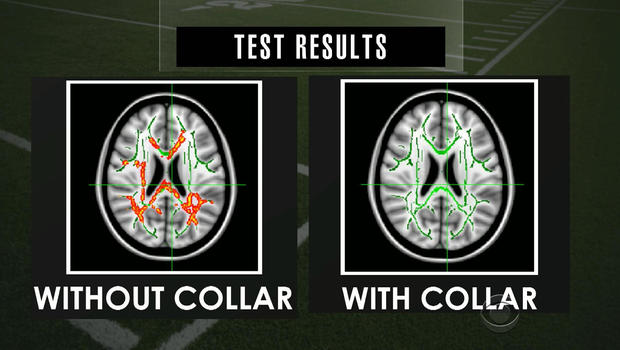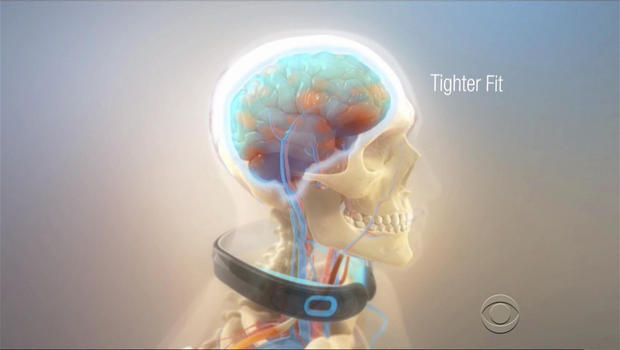In the April 2nd episode of his Radical Capitalist show on Blogtalkradio, Yaron Brook answered a question about concussions in professional football. The concerns about the long-term brain damage stemming from concussions is an issue facing not just professional sports, but sports at all levels. The local television station, WCAX, has run stories about the issue for some time, including the fact that Dartmouth College banned tackling exercises at football practices for several years but they are now possible due to a robotic tackling dummy. The new system allows players to train at closer to 100%, allowing them to fully prepare for the season while reducing the chance of injury.
While this new robotic system, developed by the college’s engineering students, could be the source of a post on success and positive values, I am actually going to discuss a newer development that is, to my mind, even more impressive. On the CBS Evening News on April 2nd there was a story about a new device developed by Julian Bailes, the character played by Alec Baldwin in the movie “Concussion,” and Dr. David Smith, CEO of Xennovate Medical, that appears to greatly reduce the damage done to the brain due to repeated impacts.
The device is a simple collar that puts slight pressure on the jugular veins on either side of the neck but leaves the windpipe free. This slight pressure increases by a small amount the blood in the brain which helps prevent the brain from “sloshing” around inside the skull with impacts or violent movements.
Dr. Gregory Myles, an independent investigator, is leading a study on the benefits of the collar and so far has not found any negative responses to using the device. Researchers have equipped high school football players with the device and have found that a player can receive 1000 routine hits to the head over the course of a season. This leads to the hypothesis that perhaps it isn’t just the big one time hits that are concerning but also that thousands of ordinary hits a player takes without even thinking about them. The collar appears to prevent damage from such repetitive impacts, as the image below indicates.

The red in the image on the left shows where there have been changes in the brain over the course of a season, changes that are missing from those using the collar.
Photo (c) CBS
The researchers will be publishing fuller results later this month, but at this point it looks promising.
“It’s unbelievable. To be honest, it’s — we’re looking at this and we’re expecting to find nothing,” Myer said. “It’s a paradigm-shifter where we change the way we study protecting the brain. This is a game changer.”
As wonderful as the potential benefits from this simple device are, equally wonderful is the story about how it came into existence. Late last year Bloomberg published a story on the device which reported about its origins. Apparently at a conference in 2007 an attendee suggested to Dr. Smith that he take a look at brain injuries, adding that if we “can figure out how a woodpecker can smash its head into a tree and fly away without a headache,” we could likely solve the problem. This led Smith to study the unique structure of a woodpecker’s head, especially the long tongue which bones that go around the jugular vein support. Smith hypothesized that this structure would compress the jugular as the woodpecker thrust its head forward to rap its beak against a tree (or silo as I’ve seen them do). This compression would trap a bit of extra blood which helped keep the brain from moving around in the skull.
Dr. Smith took his theory to Dr. Bailes and they decided to do animal trials. These consisted of dropping little weights on the heads of anesthetized rats and then testing for damage in the brain. In previous experiments, nothing had been found that would reduce the damage by even 1%, not even Kevlar or steel. The test collars they made to mimic the action of a woodpecker’s tongue in compressing the jugular reduced the brain damage in rats by an amazing 80%.
While there are skeptics, and much testing is still needed, the early results have been impressive enough to lead Performance Sports Group to invest $7 million in developing the collars. Such collars would not just be useful in football, as would be the case with the tackling dummies mentioned at the beginning of this post, but any impact sport (e.g. soccer and hockey) or job that subjects the head to impacts or repetitive violent motion.
As I was preparing to write this post I was also reading Equal is Unfair and had reached the section of the book where Yaron Brook and Don Watkins discuss egalitarianism and how that philosophy attempts to destroy the idea that successful people deserve the rewards from their success. Many egalitarians believe that if you don’t do everything yourself, then you cannot claim to deserve the rewards and so they justly be taken away from you. So, for example, if you invented the car but did not invent the wheel, engine, gasoline and etc, you don’t deserve the rewards for what you did invent. Such a belief essentially totally destroys the idea that anyone can deserve anything.
while man builds on prior knowledge, he deserves the full credit for the new knowledge he adds to that existing store Click To TweetDon and Yaron dismantle this idea pretty thoroughly in their book and I think that the development of this collar is a great example of what they talk about. They point out that while man builds on prior knowledge, he deserves the full credit for the new knowledge he adds to that existing store. It is this addition that creates the new wealth that justly belongs to he who added the knowledge.
Take the case of this collar. How many people who knew about the problem of concussions and knew about woodpeckers? Probably every doctor and trainer alive. How many people were at the conference where someone uttered the idea of looking at woodpeckers but didn’t take it any further? Probably all of them except for Dr. Smith. So while many people had all the previous knowledge to draw upon, only Drs. Smith and Bailes came up with a new application of this knowledge that will benefit many thousands of people.
Smith and Bailes took a problem that many people knew existed (brain injuries), found a possible solution to that problem in something everyone knew about (woodpeckers), and developed a product to test that solution (collars). If the product performs as early tests indicate, the millions they will make from it will be small compensation for the thousands or millions of people who will be at greatly reduced risk from this type of brain injury.

